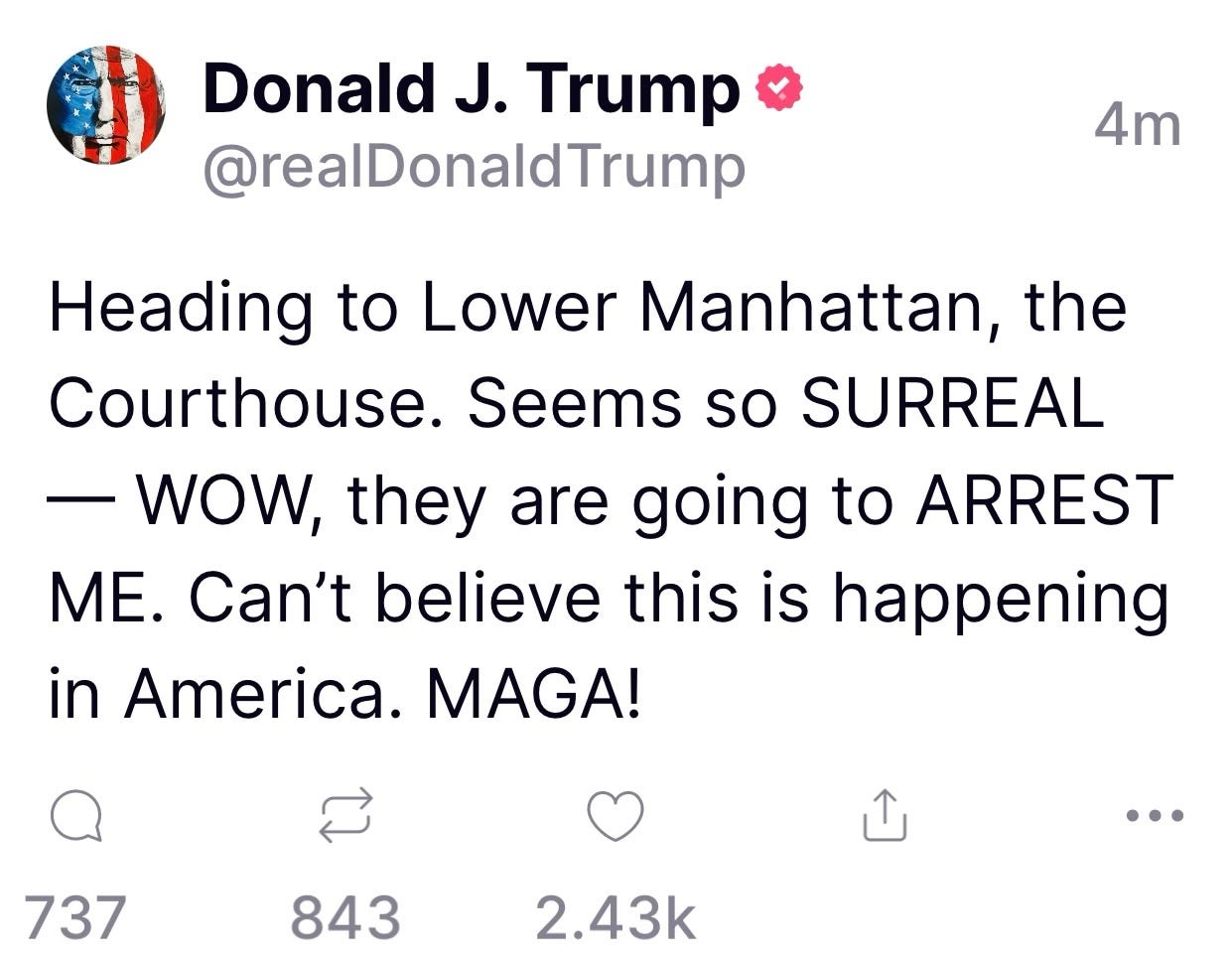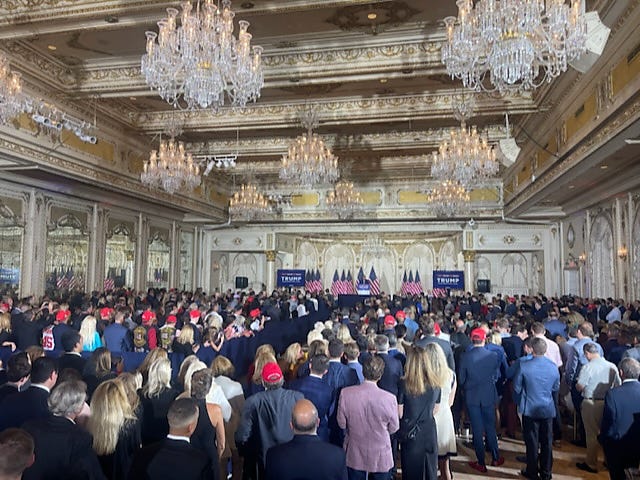Unsealed
Now we know what charges Trump faces in Manhattan
Well, today was a day. It started like this.
And by the end of the day—or rather, by late afternoon, since the indictment was made public not in advance of the hearing, as expected, but late in the day—we knew what the charges against the former president consisted of. I thought I’d pull a couple of the interesting threads for us to consider from what we’ve learned today. For starters, here are the top-level points, for those who like to do their own reading:
The indictment charges 34 felony counts of business records fraud. Read it here. That’s the charge we previewed in last night’s newsletter, so if you want a refresher on what it involves, re-read here.
The indictment is, unfortunately, a bare-bones document, not a speaking indictment that tells the story of the crime.
However, the practice in the Manhattan DA’s office, which is different from how most prosecutors operate, is to file a separate document called a “statement of facts” that details more information about the charges in white-collar crime cases. This one is dishy. You can read it here.
Donald Trump is the only defendant charged, and there is no conspiracy count.
The statement of facts is full of detail. That’s where we start tonight, with the big picture. The Manhattan DA alleges that “From August 2015 to December 2017, the Defendant [that’s Trump] orchestrated a scheme with others to influence the 2016 presidential election by identifying and purchasing negative information about him to suppress its publication and benefit the Defendant’s electoral prospects. In order to execute the unlawful scheme, the participants violated election laws and made and caused false entries in the business records of various entities in New York. The participants also took steps that mischaracterized, for tax purposes, the true nature of the payments made in furtherance of the scheme.”
The 13-page statement is a road map to how the DA intends to prove the 34 crimes that are charged in the indictment. The portion of the statement that is quoted above gives us both the context for the indictment—it’s about an effort to interfere with an election—and the details about the other crimes the DA believes he can prove Trump committed or concealed (or wanted to commit or conceal) in order to morph the basic misdemeanor false records charges into felonies. Trump was directing a scheme to interfere with the election, and he violated New York law in the process. So, tax and election crimes.
How did the scheme work? At a meeting in August of 2015, publisher David Pecker (then the head of AMI), Michael Cohen, and Trump met and concocted a “catch and kill” plan to prevent damaging stories about Trump from surfacing during the election. Pecker “agreed to help with [Trump’s] campaign, saying that he would act as the ’eyes and ears’ for the campaign by looking out for negative stories about the Defendant and alerting Lawyer A [Michael Cohen] before the stories were published.” The result was three instances where they were able to prevent damaging information about Trump from coming to light while he was running for office. The payoff to keep Stormy Daniels quiet, involving $130,000 paid to her through Michael Cohen and a shell company, was expected. The surprise was the inclusion of the $150,000 payment to another woman who was shopping a story about an affair with Trump, Karen McDougal, and a $30,000 payment to a doorman at Trump Tower with a story, later rejected by AMI, that Trump had fathered an illegitimate child. That’s the scheme. The indictment charges the lies used to further it, 34 of them.
Here’s how the 34 break down. There are 11 counts related to falsified invoices. There are 12 counts related to falsified general ledger entries. There are 11 checks falsely recording Stormy Daniels’ hush money repayments as a legal retainer to Michael Cohen. It’s a simple and elegant series of charges, all wrapped in the election context.
Manhattan DA Alvin Bragg offered two reasons his office had to bring the case. First, it was about protecting American elections. Trump supporters who had suggested the “catch and kill” scheme was about protecting Melania Trump saw that defense blow apart today—Trump met with Pecker after the election and before the inauguration to thank him for his help with the election. They met again after the election and before the inauguration, where Trump “thanked the AMI CEO for handling the stories of the Doorman and Woman 1 [Karen McDougal], and invited the AMI CEO to the Inauguration.” After Trump became President, he invited Pecker to a White House dinner in the summer of 2017 “to thank him for his help during the campaign.” Pecker is cooperating. He was the final witness Bragg brought before the grand jury, and, presumably, we will hear this story in his own voice. Here’s the chef’s kiss. They structured at least one of the deals so they wouldn’t have to pay out funds if Trump lost the election. It was never about protecting Melania.
Bragg offered a second reason the prosecution was important: “Because it’s New York, and business integrity and markets and accurate record-keeping matters; that’s why we charged. It’s falsification,” he emphasized with an emphatic gesture, of “New York State business records.” Bragg pointed out that given Manhattan’s status as a center of financial activity, these are “bread and butter crimes” for his office.
So the charges in the indictment make sense, and there is a strong, apolitical justification for bringing it. Bragg also responded to questions about why he decided to bring the case by saying they had access to new evidence, although he didn’t specify what form that took. Nonetheless, I do have some questions about the indictment.
First, why isn’t there a conspiracy charge? No answers to that today. The statement of facts uses conspiracy language and seems to suggest there was a conspiracy between Pecker, Cohen, and Trump. There are strategic reasons prosecutors like to use conspiracy charges, including the fact that they permit evidence to be introduced that can be difficult to get in otherwise—for instance, conversations among co-conspirators. But the Manhattan DA has had months to consider his case, and, presumably, he had good reasons for the charging decisions he made.
Second, why isn’t there more specificity about the crimes the DA is alleging to upgrade the misdemeanors to felony charges? Our expectation, as we’ve discussed the possible shape this indictment might take, was that we’d see tax crimes and election crimes. And we do. But we still don’t know much more than that. The DA explained in his press conference that he is including both federal election crimes involving caps on contributions and state provisions that prohibit illegally affecting an election, as well as state tax crimes. It would have been nice to have a little bit more speaking in the indictment, so we could have a better understanding of the theories Bragg is going to advance on this key point. There’s enough to let us know that he has multiple paths to converting his misdemeanors into felonies, but the appellate lawyer in me wants all of the specifics. And there are legal challenges looming here—there will be questions about whether a state election law applies to a federal election and others about whether a state prosecutor can apply a federal law here. That may make the tax charges the goldilocks provision in the mix.
To be fair, it’s apparently the practice in New York to indict a case like this without referencing the specific criminal violations that enhance the false records charges. And it would be a mistake to treat this case differently from other cases. If prosecutors had, Trump’s lawyers would likely be complaining about the additional information in the indictment. Now, they’re likely to file a motion asking for more specificity. We’ll learn the answers as the case progresses, but it would have been nice to have it all laid out for starters.
One final note: In a jury trial, these charges aren’t all or nothing. The jury could return felony convictions if they think the prosecution has proved its case. But if they believe the records were falsified, but that the evidence doesn’t establish that another crime was involved, they could return guilty verdicts on the misdemeanor charges—what’s called a lesser included offense. I don’t think that’s going to be the case, but it’s important to know there could be felony convictions, misdemeanor convictions, or acquittals, and the jury votes separately on each charge. There are multiple paths to conviction.
A few weeks ago, I wrote to you that “Some people have suggested that the charges under consideration in Manhattan are insignificant. . . . I don’t see it that way. The Stormy Daniels incident is the origin story for Trump’s efforts to manipulate elections in unfair ways.” The indictment confirms that’s true. The chandeliers may have been sparkly at Mar-a-Lago tonight for Trump’s recitation of grievance, but his lawyers, if not he, understand they have a difficult, albeit lengthy, path ahead that is very likely to result in a number of convictions.
The next hearing in this case isn’t scheduled until December 4. That’s a long ways off. In the meantime, the prosecution and the defense will file pretrial motions and conduct discovery. Trump is presumed innocent until proven guilty and he has a right to remain silent (if he can). But this won’t be the only storm he has to weather for long. The E. Jean Carroll trial starts on April 25, in a federal courtroom, also in New York. And there is the prospect of additional criminal indictments.
We’re in this together,
Joyce





Thank you Joyce for spelling this out so well. It’s been quite a day! My feeling is things aren’t looking good for the don. And he will drivel on with his grievance and continue to grift but he may have met his match. And there is still Fani Willis and Jack Smith around the next corner. And thank you E. Jean for holding him accountable.
Professor Vance, I write principally to note that what most resonates, at least for me, is how, from the outset, you had framed the Manhattan charges as an “origin story” of an ongoing scheme to override the will of the people. In many respects, April 4th marked the beginning of sketching a narrative extending over a series of years portraying a former, twice-impeached-now-indicted president who has undermined democracy and the rule of law and who, until recently, had managed to avoid accountability. That said, even as we wait on subsequent allegations for election interference and for efforts to reverse the 2020 election count, I suggest we stay laser-focused on what’s expected of us to help ensure we prevail up and down the ballot in 2024.